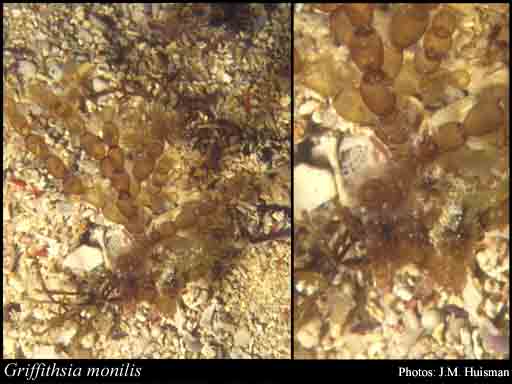- Reference
- Trans.Roy.Irish Acad. 559 (1855)
- Conservation Code
- Not threatened
- Naturalised Status
- Native to Western Australia
- Name Status
- Current

Scientific Description
Habit and structure. Thallus dark red, 1.5–4.5(–8) cm high, branching spreading, several times subdichotomous, ecorticate, distinctly moniliform throughout. Attached by filamentous rhizoids from cells near the thallus base; epilithic or epiphytic. Structure. Cells prolonged at their bases into a short neck, near the thallus apex globose, 0.5–2 mm in diameter, in mid thallus globose to ovoid, 1.6–2.5 mm and L/D 1–1.3, basal thallus cells ovoid, rarely cylindrical. Filaments strongly constricted between cells, attenuate towards the apices.
Reproduction. Gametophytes dioecious. Female axes subapical, of 3 small, discoid cells, displaced laterally or into an apparently terminal position by the continued growth of the vegetative axis, sometimes arising in opposite pairs on the same vegetative cell, flanked by caducous, hair-like synchronic laterals; procarps systems subapical, each with a sterile lateral cell and a supporting cell bearing a sterile cell apically and 1–2 recurved carpogonial branches of 4 cells laterally; hypogenous cell producing abaxially 2-celled synchronic involucral branches with swollen terminal cells; post-fertilisation fusion cell columnar, bearing 1–3 gonimolobes terminally, most cells of which form globose-ovoid carposporangia, 27–45 µm in diameter. Spermatangia borne on whorls of numerous, minute, fascicles from the upper shoulders of vegetative cells near the thallus apex, clustered in the constrictions between cells, each fascicle initially a pedicel bearing 5 polychotomous branches developing 2–8 further terete axial cells each bearing whorls of 5 polychotomous clusters producing spermatia terminally; involucral cells absent, or present in var. cincta. Tetrasporangia produced successively in clusters of 2–12 on whorls of numerous, minute, fascicles in similar positions to the spermatangial masses, globose or lachrimiform, 50–80 µm in diameter, tetrahedrally divided; fascicles internal to a cluster consisting of single terete pedicels, those peripheral to a cluster developing 1–3 further small axial cells, the basal cell displaced into a recumbent position by the production of a swollen reniform involucral cell, often apically furcate, 210–410 µm long and 130–180 µm in diameter.
Distribution.Rottnest I. and Fremantle, W. Aust., to Tas. and N.S.W.
Habitat. G. monilis isfound in the lower eulittoral to 5 m deep.
[After Womersley, Mar. Benthic Fl. Southern Australia IIIC: 333–334 (1998)]
Distribution
- IBRA Regions
- Swan Coastal Plain.
- IBRA Subregions
- Perth.
- IMCRA Regions
- Central West Coast, Leeuwin-Naturaliste, WA South Coast.
- Local Government Areas (LGAs)
- Coorow, Dandaragan, Esperance, Joondalup, Mandurah, Rockingham, Wanneroo.